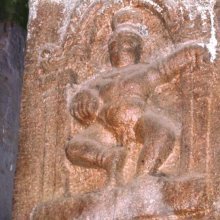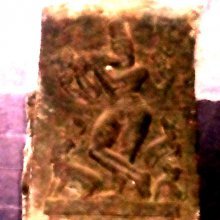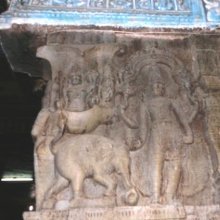Gopala, Gopāla, Go-pala: 29 definitions
Introduction:
Gopala means something in Buddhism, Pali, Hinduism, Sanskrit, the history of ancient India, Marathi. If you want to know the exact meaning, history, etymology or English translation of this term then check out the descriptions on this page. Add your comment or reference to a book if you want to contribute to this summary article.
Gopala has 27 English definitions available.
Images (photo gallery)
(+4 more images available)
Languages of India and abroad
Sanskrit dictionary
[Deutsch Wörterbuch]
Source: Cologne Digital Sanskrit Dictionaries: Böhtlingk and Roth Grosses Petersburger WörterbuchGopāla (गोपाल):—(go + pāla) [Vājasaneyisaṃhitā] [The Śatapathabrāhmaṇa] gopāla [Pāṇini’s acht Bücher 6, 2, 78.]
1) m. a) Kuhhirt [Amarakoṣa 2, 9, 57.] [Trikāṇḍaśeṣa 3, 3, 390.] [Hemacandra’s Abhidhānacintāmaṇi 889.] [Anekārthasaṃgraha 3, 644.] [Medinīkoṣa l. 86.] [Vājasaneyisaṃhitā 30, 11.] [The Śatapathabrāhmaṇa 4, 1, 5, 4.] [Manu’s Gesetzbuch 4, 253.] [Yājñavalkya’s Gesetzbuch 1, 166.] [Mahābhārata 3, 14700. 4, 175.] [Harivaṃśa 4080.] [Suśruta 1, 136, 3.] grāmakāmaṃ ca gopālam [Pañcatantra III, 72.] [Bhāgavatapurāṇa 9, 2, 3.] Am Ende eines adj. comp. f. āḥ agopālā yathā gāvaḥ [Rāmāyaṇa 2, 67, 25.] — b) der Herr der Erde, König [Trikāṇḍaśeṣa] [Hemacandra’s Anekārthasaṃgraha] [Medinīkoṣa] Kuhhirt und König zugleich: gopālena prajādhenorvittadugdhaṃ śanaiḥ śanaiḥ . pālanātpoṣaṇādgrāhyam [Pañcatantra I, 249.] — c) der Kuhhirt κατ´ έξοχήν, Kṛṣṇa [Mahābhārata 3, 15530.] gopālapūjāpaddhati [Weber’s Verzeichniss No. 1321.] — d) ein Beiname Śiva’s [Hemacandra’s Abhidhānacintāmaṇi 42.] [Medinīkoṣa] — e) Nomen proprium eines Wesens im Gefolge von Śiva [VYĀḌI] zu [Hemacandra’s Abhidhānacintāmaṇi 210.] [Harivaṃśa] [LANGL. I, 512.] — f) Nomen proprium eines Nāga [Hiouen-Thsang I, 99.] — g) Nomen proprium eines Ministers des Königs Bimbisāra [Lebensbeschreibung Śākyamuni’s 252 (22). 268 (38).] eines Königs [WASSILJEW 54. 80.] eines Feldherrn (und Brahmanen nach dem [Scholiast]) des Königs Kīrtivarman [Prabodhacandrodaja 2, 8. 3, 9.] eines Fürstensohnes ( = gopālaka) [Kathāsaritsāgara 16, 103.] gopālacakravartin Nomen proprium eines Scholiasten [Colebrooke II, 46. 57.] gopālācārya [Weber’s Verzeichniss No. 540.] gopālamiśra [1321.] āvasathika [266.] śrīmad [736. 1168.] —
2) f. ī a) Nomen proprium einer der Mütter im Gefolge von Skanda [Mahābhārata 9, 2622.] — b) Nomen proprium einer Tschāṇḍālī [Burnouf 377.] — c) Name zweier Pflanzen: α) = gopālakarkaṭī . — β) = gorakṣī [Rājanirghaṇṭa im Śabdakalpadruma]
--- OR ---
Gopāla (गोपाल):—
1) g) jī [HALL 93.] tīrtha [168.] bhaṭṭa [171. 193. fg.]
Source: Cologne Digital Sanskrit Dictionaries: Sanskrit-Wörterbuch in kürzerer FassungGopāla (गोपाल):——
1) m. — a) Kuhhirt. Am Ende eines adj. Comp. f. ā. — b) Fürst , König. — c) Beiname — α) Kṛṣna's. — β) Śiva's. — d) Nomen proprium — α) Fischerdämons [Harivaṃśa 9556.] — β) eines Schlangendämons. — γ) verschiedener Fürsten , Staatsmänner und Gelehrten ([Kumārasvāmin] zu [Pratāparudriya 288,1]) Auch cakravartin , jī , tīrtha , bhaṭṭa , miśra , gopālā , cārya , āvasathika , śrīmadgopāla. —
2) f. gopālī — a) *eine Gurkenart und *eine anderer Pflanze. — b) Nomen proprium — α) einer der Mütter im Gefolge Skanda's. — β) einer Cāṇḍālī.
Sanskrit, also spelled संस्कृतम् (saṃskṛtam), is an ancient language of India commonly seen as the grandmother of the Indo-European language family (even English!). Closely allied with Prakrit and Pali, Sanskrit is more exhaustive in both grammar and terms and has the most extensive collection of literature in the world, greatly surpassing its sister-languages Greek and Latin.
See also (Relevant definitions)
Partial matches: Go, Paala, Pala.
Starts with (+105): Gopala acarya, Gopala avasathika, Gopala bhatta, Gopala bhatta guha, Gopala cakravartin, Gopala kavi, Gopala mishra, Gopala nyayapancanana, Gopala nyayapancanana bhattacarya, Gopala pandita, Gopala paramahamsaparivrajakacarya, Gopala sarasvati, Gopala sharman, Gopala siddhanta, Gopala siddhantavagisha, Gopala yogin, Gopalabhatta, Gopalabutti, Gopalacaitanya, Gopalacakravartin.
Ends with (+2): Abalagopala, Agopala, Balagopala, Bhatta gopala, Bhattagopala, Gandagopala, Jayagopala, Jegopala, Kandagopala, Keligopala, Lauhityabhattagopala, Madanagopala, Maunagopala, Nandgopala, Rajanaka gopala, Ramagopala, Samtanagopala, Santanagopala, Sategopala, Tirthagopala.
Full-text (+323): Gopalamatha, Gopalakeshava, Gaupalayana, Gaupalapashupalika, Gopalacampu, Gopalakalpa, Gopaladhanipulasa, Gopalarahasya, Gopalatapini, Gopalatapaniyopanishad, Gopalamishra, Gopalabhatta, Gopalacakravartin, Gopalatirtha, Gopalakelicandrika, Gopalasahi, Gopalaprasada, Gopalavarman, Gopalagiri, Gopalapura.
Relevant text
Search found 77 books and stories containing Gopala, Gopāla, Go-pala, Gōpāla, Go-pāla, Gōpāḷa; (plurals include: Gopalas, Gopālas, palas, Gōpālas, pālas, Gōpāḷas). You can also click to the full overview containing English textual excerpts. Below are direct links for the most relevant articles:
Brihad Bhagavatamrita (commentary) (by Śrī Śrīmad Bhaktivedānta Nārāyana Gosvāmī Mahārāja)
Verse 2.1.63 < [Chapter 1 - Vairāgya (renunciation)]
Verse 1.2.20 < [Chapter 2 - Divya (the celestial plane)]
Verse 2.1.92 < [Chapter 1 - Vairāgya (renunciation)]
Garga Samhita (English) (by Danavir Goswami)
Verse 1.4.50 < [Chapter 4 - Description of Questions About the Lord’s Appearance]
Verse 4.14.3 < [Chapter 14 - The Story of the Jālandharīs]
Verse 5.19.8 < [Chapter 19 - The Festival on Śrī Kṛṣṇa Return]
Chaitanya Bhagavata (by Bhumipati Dāsa)
Verse 2.24.15 < [Chapter 24 - The Lord Displays His Universal Form to Advaita]
Verse 1.9.154 < [Chapter 9 - Nityānanda’s Childhood Pastimes and Travels to Holy Places]
Verse 1.5.18 < [Chapter 5 - Eating the Mendicant Brāhmaṇa’s Offerings]
Sahitya-kaumudi by Baladeva Vidyabhushana (by Gaurapada Dāsa)
Text 9.41 [snake diagram] < [Chapter 9 - Ornaments of Sound]
Text 4.66 < [Chapter 4 - First-rate Poetry]
Text 11.53 < [Chapter 11 - Additional Ornaments]
Puranic encyclopaedia (by Vettam Mani)
List of Mahabharata people and places (by Laxman Burdak)
Related products






